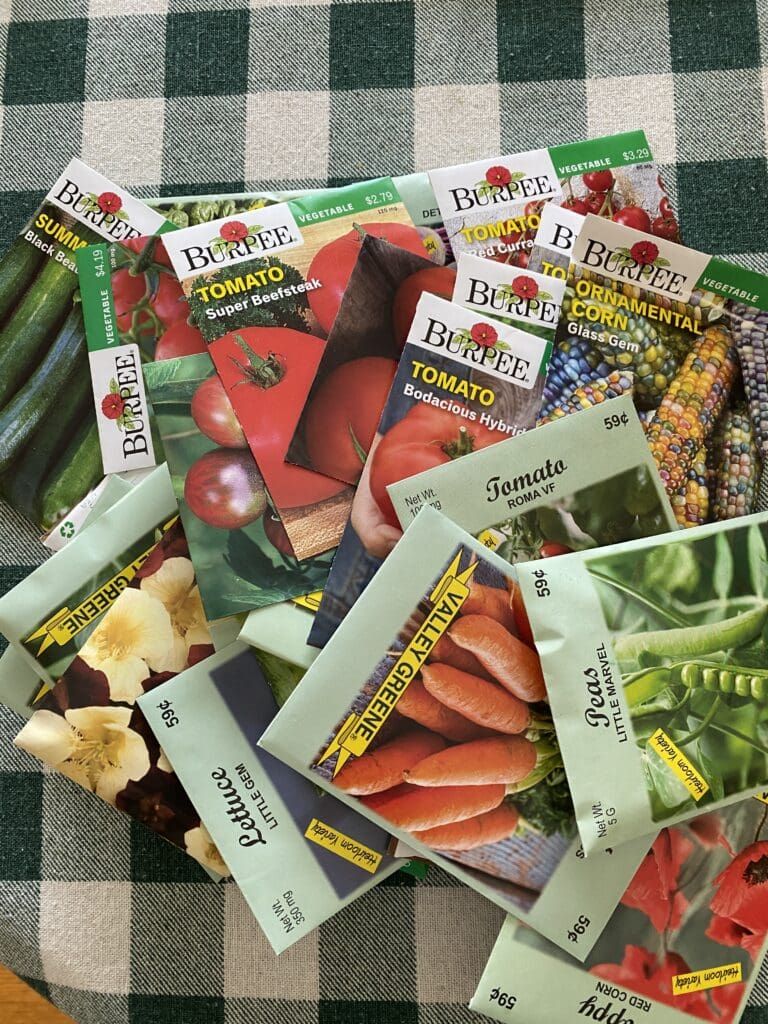
Last year, I introduced you to gardener math and also provided some important updates a few months later.
This is a subject I’ve been studying off and on for quite some time, and today, I’m ready to reveal some recent findings and revelations about seed math, a subset of gardener math.
(I’ll pause while you go read those two blog posts and get yourself caught up.)
Now a little quiz.
I went to Menards to buy some batteries because I needed some lithium batteries for the outdoor temperature sensor for my thermostat. The thermostat had a nice orange message on it yesterday, alerting me to the need to replace the batteries on the outdoor temperature sensor with two AA lithium batteries. Yes, they were quite specific that the batteries should be lithium. No, I don’t know if the outdoor temperature reading affects how the HVAC system works, but it is the middle of winter so I decided to replace those batteries as soon as possible, even though I think it just shows the outside temperature for convenience.
Anyway, while at Menards, I saw that they had seeds on sale. No harm in looking, even though I haven’t sorted out the seeds I do have, and I would have to guess at what I needed.
And you are correct. That “do I need them” question did not stop me from purchasing several packets of seeds.
Now, here is the question. How much did those seeds cost?
What is your guess/answer?
If you answered “free,” that is correct.
No, I did not steal them! Allow me to explain how they were free as several gardener math concepts apply here.
First, all the seeds that were marked 59 cents were on sale for ten cents. One dime! That makes them free because what is a dime really worth these days? If you dropped a dime into a big ol’ pile of gray, slushy snow, would you make an effort to retrieve it and get your hands filthy dirty? I think not, which means that dime isn’t worth anything to you, so those seed packets that cost a dime were essentially free.
Also, if you live in the Midwest where there are Menards stores, you are no doubt familiar with the 11% rebates they offer for most of the year, except right before the Christmas holidays and into January. I just happened to have two rebate certificates from past purchases, which I remembered to take with me into the store, which almost exactly covered the price of the seeds!
That made the seeds free! I just had to pay for the batteries.
Plus, if you read that post with important updates to gardener math, you already knew that the seeds would be free because I went to Menards for batteries not seeds. Duh.
Also, in gardener math, seeds are never a gardening expense when they are purchased to grow food. They are a grocery expense. Even flower seeds are a grocery expense when grown to lure in pollinators to pollinate those garden crops.
But that is all review for those of you who read those old posts.
A new gardener math concept relates to how many seeds are in a packet. Let’s say you buy a packet of seeds for ‘Glass Gem’ corn, which can be more expensive than other varieties, and someone asks how much those seeds were. Never, ever answer with the price on the packet. Answer with a price per seed. For example, let’s say there were 20 seeds in that packet, and it was on sale for $2. That makes each seed ten cents. See above about ten cents being free!
Now, someone is going to ask about the price of seed trays, seed lights, seed starting soil mix, etc. and ask if that should be figured into one’s seed budget?
First, what is a seed budget?
Second, no.
Those are supplies you should have on hand or re-use from year to year. If you just bought them, figure out their useful life in years, divide the cost by the number of years, then only use that lower number for your seed growing supply costs for the year. Classic depreciation. Or just forget what they cost and consider them free every year you use them, which is what I do.
One more concept related to seed math. Have you ever saved seeds? Saved seeds as we know are free seeds and they can also be considered a way to offset the cost of new seeds. Those fancy heirloom sweet pea seeds that cost some real money? Go ahead and get them because you can save some seeds to sow next year. When you do that, you aren’t really spending money, you are investing! In seeds! And investing is a way of saving, not spending!
How magical!
Just like seeds!
I hope this post has helped you as you go forth and buy seeds for your garden this year.


Laughing through the truth my new found gardening friend! Listened to last weeks podcast will follow through with this week too and I’m sure go back to your past episodes. Such a gift. Makes me feel friends having a coffee and talking with you both!
You influencer, you. Went out in minus 15 degrees, got my $1.00 worth of seeds! And truly free, with my rebate🥳 Now, come spring!
I made a special trip to the local garden center with the good seeds, and when I arrived, I drooled over them. But then I realized that I forgot to check my seed stash first, so I left without buying any. Did you hear me? I LEFT WITHOUT PURCHASING ANY SEEDS. I should get a medal. I’ll be back soon, after checking my stash. I’ll use gardening math to make them free, don’t worry.